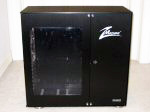Zalman Z-Machine GT1000 High End Gaming Case
Closer Look: Outside

|
Soon after taking the GT1000 out of its box, we could tell that the case looked as good as the pictures on the box and on Zalman's web site. Immediately, you can tell that Zalman took a different approach with the GT1000's design. While most cases feature one-piece, removable panels on each side of the case, the GT1000 sports two-piece panels that remind us of hinged doors. The right panel doors are secured by screws that have hexagonal sockets in the heads (hence the inclusion of the Allen wrench, or hex key). The left panel doors are secured by thumbscrews, and the bigger side features a window. Each side of the case is also adorned with a couple Zalman logos and an arrow with "Open" written inside of it.
Each part of each side is held on by two screws that are at the top and bottom of the sides. We appreciate Zalman's choice of thumbscrews for the left side. They make it very easy and convenient to get into the case. After removing the screws, each part of the panel can be swung open, but the panels aren't designed to be removed.
When we turn the GT1000 to look at its front, you can see its four external 5.25" bays and one external 3.5" bay. One of the 5.25" bay covers sports a Z-Machine logo. Beneath the external bays, you will notice the power button, power LED, hard drive activity LEDs, reset button, microphone jack, headphone jack, two USB ports, and a IEEE1394 (FireWire) port. Finally, at the bottom of the case's front, you can see the grill in front of the two 92mm fans.
Once we turn the case around to check out the back, it looks fairly typical. At the top, you see the empty area where the PSU goes, and beneath that, there is the empty rear I/O panel, a 120mm fan with a metal fan grill, and the expansion card slots. Interestingly, Zalman even included some logos back here. That's not all, though. There's even a warning below the fan to be cautious of ESD (electrostatic discharge) when handling expansion cards.
Overall, we think the outside of the case looks great. We like the simple, clean style of the brushed aluminum. We have to move beyond the surface, though, to see if we have a good case on our hands. A case that looks great but isn't very functional won't appeal to users, so let's open the GT1000 up to check if the internal design matches the great looks of the outside.














